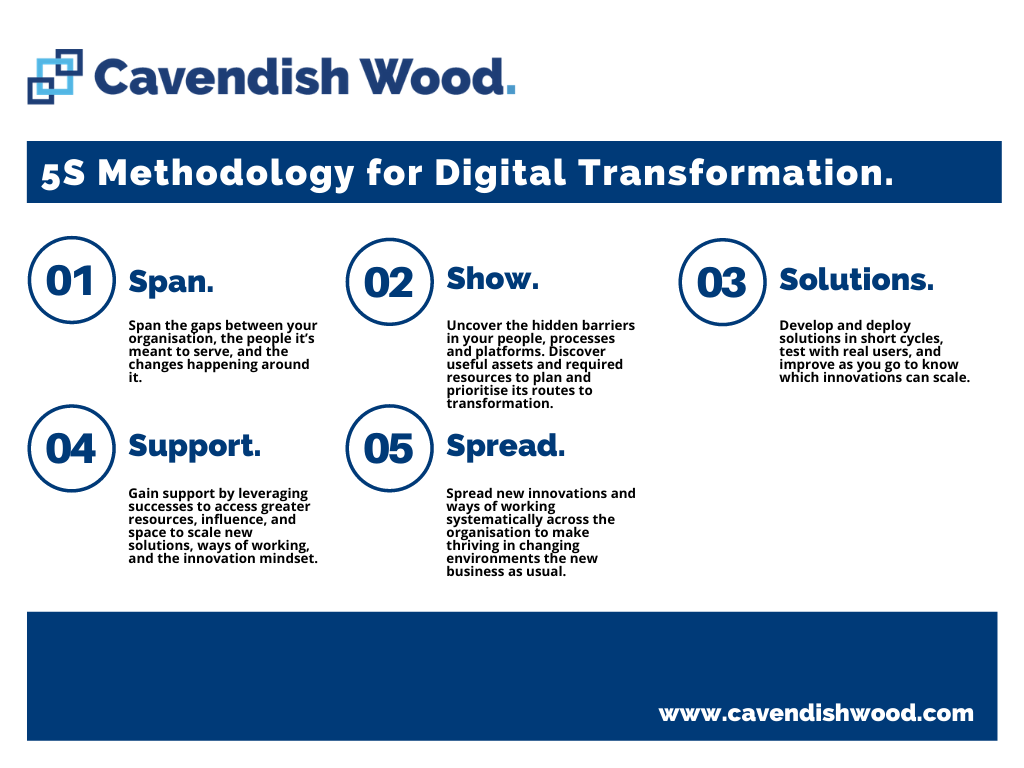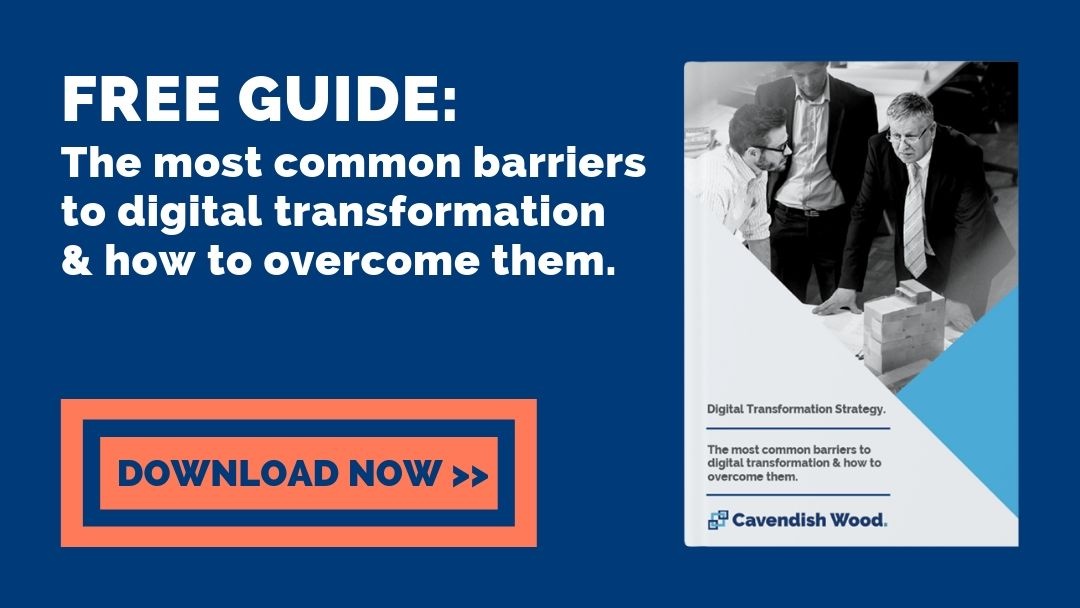
In my last two blogs about local government digital transformation, I discussed the three key objectives that local authorities must drive their digital programmes towards, some of the issues and challenges that are common across all levels of local government and the key reasons that transformation can often seem like an impossible destination for your organisation.
SKIP TO ALL STAGE EXPLANATIONS:
I also introduced the “5S Methodology for Digital Transformation” which was developed by Cavendish Wood out of the last five years working hand in hand with public and private sector organisations to deliver meaningful and lasting transformation.

In this third part of the series “Local Government Digital Transformation – A Blueprint for Success” I’ll introduce phase three of the methodology: “Solutions”.
In phase one, “Span” you built meaningful connections from the interior of your organisations to the outside world. Undertaking dialogue with customers, peers and partners to gain tangible information and data to enable you to understand exactly what needs to change and how quickly.
You used that intelligence to define a “Shared Vision for Transformation”. A succinct set of statements that outlined where the organisation is today, a vision for the future and why it needs to change.
You also appointed a leadership group responsible for driving transformation forwards, ensuring resource and budget is available to set out on your digital journey.
Then, in phase two “Show” you flushed out all of the barriers to transformation that are hidden in your organisation. You also found critical assets and resources and started to plan and prioritise the initial projects to be tackled as you set out to achieve your vision for digital transformation.
Solutions.
This phase of transformation is where the rubber really meets the road. This is where you will start to develop solutions to the prioritised business problems and opportunities you uncovered in the previous two phases. This is also where the approach required for success can be a challenge to many local authorities.
Before I get into exactly how to develop solutions, we should talk a bit about how not to approach this. Digital Transformation is stressful. You are setting off towards a largely unknown destination, with unknown obstacles and costs and in most local authorities a considerable amount of resistance and scepticism. This can really ramp up the pressure to succeed and can have a significantly negative impact.
This kind of pressure and scrutiny often causes one of two things to happen:
Firstly, in a bid to keep people happy and onside, leaders turn to traditional management techniques. Project plans, risk logs, budgetary structure. None of this is helpful to digital transformation. Because at this point, the solutions are unknown, any planning is at best guesswork and therefore pretty much doomed to fail. This pressure is almost always driven by Finance who, often view themselves as outside of the scope of digital transformation. This is a big mistake, and attempting to force digital change through 1, 3 or 5-year budget planning is an absolute recipe for disaster.

So how should we approach this critical aspect of transformation?
In a word, iteratively. Iteration is the key to delivering successful solutions. Developing solutions iteratively minimises waste, achieves project value as early as possible and guarantees that solutions are fit for purpose. Because we can get real user feedback after every iteration, if something isn’t going to work, then we know about it as soon as possible and can either change the solution, or in some cases simply stop the project there and then, before significant time, resource and budget has been wasted.
Iterative development doesn’t need to be a fully Agile lifecycle, adhering to every role and ceremony in the Agile methodology isn’t necessary. That’s not to say of course that you shouldn’t. But in most Local Authority environments, a pure Agile organisation is a step too far, and may actually hinder progress. Instead, I usually recommend taking some of the Agile framework, and elements of other approaches such as Design Thinking and LEAN. Both of these frameworks include aspects such as continuous improvement, user-centric solution design and development, and prototyping which are critical aspects of developing solutions in the digital age.
However, before you go off and start iterating, there are a few things that you need to have in place. Because this is such a new way of working for most local authorities, you’re going to need some new process, governance and organisational changes to ensure that this kind of rapid solution delivery works.
Innovation framework.
If you read my last two blogs which talked about the first two phases of the “5S Framework for Digital Transformation”, then you’ll have got the message loud and clear that digital transformation must be a business-led process. Neither IT, nor the digital programme team can or should guess what your internal and external customers need from each service area.
The knowledge of processes, customer pain points, opportunities for more efficient services, new revenue streams and all of the benefits that digital can bring sit squarely within the business. Those people need a robust, clear and simple process so that their voices are heard, and their ideas for digital change are continuously flushed out, appraised and if the benefits are there, moved through the pipeline to delivery.
There are many ways to do this. Developing a collaborative tool with PowerApps is a great way to engage every person in the organisation and give them a simple and highly visible way to raise ideas for digital initiatives, provide transparency on decision making and track the value being delivered through the programme of work. This can also serve to show them the capability they already have at their fingertips. Or simply make a Sharepoint list and give the organisation access to add ideas. As long as there is a defined and mandated way of getting the knowledge out of people's heads and into the digital programme for review and analysis then the solution doesn't need to be complex.

Project evaluation & approval process.
Following on from the process to flush out innovation from the business areas of your organisation, is a process to evaluate and approve or reject each idea. This is a relatively simple undertaking but nonetheless critical, to the overall success of the digital programme.
As each idea is submitted, the programme should deploy a business analyst to ratify and expand upon the benefits forecasted by the business for each idea. If the benefits stack up under a little more focussed scrutiny, then potential solutions can be discussed and appraised. It’s important to do this centrally, as there are often solutions to achieving business objectives already in existence within other areas of the organisation.
For example, one area of the business that may need to find a way of reviewing and approving requests for a particular service may simply be able to use a tool or application that already exists instead of building something bespoke or buying another off the shelf solution. This saves time and money and should always be the first question.
Once the potential solution has been identified and the business agrees that it meets their needs, and everyone is clear about the costs and the benefits, then this can be approved, budget assigned, and the project can move into the project list ready to be delivered.
Benefits management framework.
Once you’ve got people bringing their ideas for digital change to the programme, you’ve evaluated the likely benefits and the proposed projects support the organisation’s transformation goals, then it’s critical that a framework exists to track and report on the benefits being driven from every digital initiative across the organisation.
This is key to unlocking the value of digital change in your organisation. If this isn’t currently happening in your organisation then it’s very likely that there are innovative ideas being delivered, but with no centrally visible benefits reporting in place, they go unnoticed. However, large initiatives such as a migration to Microsoft 365 which is essentially just a cost with no immediate benefit are very visible. This causes real issues as senior leadership and council members view this as the organisation’s digital transformation. So essentially, they just see cost and not the benefit that comes later.
For example, migrating to Microsoft 365 doesn’t change anything. But a legal department that then use the Power Apps suite or SharePoint Workflow to automate document reviews and case management without needing to bring in any external capability saves hours of manual processing, retires a legacy system and the support and license costs that came with it. But these benefits often go unreported, while the senior leadership team are still fixated on the costs of migrating onto Microsoft 365 in the first place.

This could be happening all over the organisation. Imagine how much benefit you could actually deliver through digital innovation that is simply not being reported, while still feeling the pressure of the initial cost of a platform. Capturing every benefit from pounds saved to efficiencies gained is critical. This IS the digital transformation.
Another key aspect of the benefits management framework is that it must be updated as the projects are completed so that forecasts can be replaced with actuals. If this step isn’t undertaken then you’ll likely get a very inaccurate set of data which doesn’t do anyone any good. So, ensure that benefits forecasted and benefits delivered are captured separately. This can also provide good data for analysis. If benefits are consistently falling short of forecasts then this can be identified and the underlying causes addressed. Remember, digital transformation is about genuine, on the ground transformation of the business. So over-egging the forecasts is ultimately futile and sometimes terminally self-defeating for the momentum of the programme.
Prioritised project list.
To come up with a prioritised list of projects you’ll have needed to go through both the previous phases of transformation that I discussed in instalments one and two of this blog series. It is not possible to either define any projects or prioritise them if you do not fully understand the high-level transformation goals of your organisation, or the barriers which already exist which can, and probably will, stop you from achieving these goals.
You may have defined any number of transformation goals, however, some of these may have a higher priority than others in your overall strategic vision. Similarly, the “Paths to Transformation” you defined in Phase 2 of transformation “Show” will almost certainly all have their own priorities too according to your overall vision.
These strategic priorities, alongside more tactical thinking around budget, quick wins and best return on investment should serve to enable a priority to be given to each project. It is critical that everyone understands these priorities. Some business areas may feel like they’re getting left behind so close engagement and good communications around why certain projects are higher up the list than others is essential to ensure that these business areas continue to contribute to innovation without losing interest or feeling disenfranchised from the process of transformation.
The last point to note on the prioritised project list is that this is NOT a plan. It is not a project plan, it is not a programme plan. It isn’t linked with resource planning, budget planning or dependencies. It must remain a list. If this list is allowed to turn into a plan, it is almost doomed to failure.
Solution development lifecycle.
It stands to reason that before you start iteratively developing solutions, you’ll need to have defined a process to do this. It’s a very different way of working to that which most local authorities are used to. However, innovation depends on a very different mindset and approach than the delivery of standard IT type changes where almost all projects are singularly focussed on the finished product.
This focus can really impact the ability to be innovative, as to be innovative means that rapid experimentation, prototyping and early user feedback is critical. This means having the freedom to try things that may not work. But the point is to do this quickly, without wasting time and money, and without being focussed on the finished product. Sometimes without even knowing what the finished product is going to look like. This is a challenging new way of working for a lot of organisations, not least of all local authorities who are often more traditional in their approach to change.
However, this is part of your transformation. The way in which you react to, and deliver change is one of the key building blocks of being a digital-first organisation. Without mastering this aspect your transformation cannot succeed.
Because of the iterative, transparent, and collaborative nature of this approach, there are some fundamental changes that can be achieved which will vastly improve the likelihood of a successful transformation.

Whereas the previous focus on the solution would cause decisions to be made on intuition and seniority, this approach allows decisions to be made based on testing and real user feedback. Testing ideas were often expensive, and prohibitively so because any testing that wasn’t based on the finished solution wasn’t perceived to have any value. Any testing that did take place would be infrequent and often needed to be conducted by expensive experts.
In the digital world, testing ideas is cheap, fast and easy, and should be conducted constantly by everyone. This means that failure is rapid, early and very cheap. In fact, it is now a good thing to fail and it is an inevitable part of the process of innovation because it provides the learning needed to succeed. In the legacy world of waterfall projects failure had to be avoided at all costs. By focussing on prototypes, minimum viable products and iteration after launch we can totally remove the focus of a ‘finished solution’ which often stops innovation dead in its tracks.
So what does a process like this look like?
Well, very simple actually. It’s really not necessary to adopt an entirely Agile methodology with all of the ceremonies that go with it. It’s much better to take the bits of this that work for your organisation.
Although Agile is the most commonly used methodology for running iterative projects, it is quite heavy in terminology and complex processes that really aren’t necessary to enable most organisations to still achieve the objective. Pure Agile was developed to deliver software and so it isn’t suitable for most projects without a certain level of customisation.
In simple terms, Agile enables a collaborative and cross-functional team to plan, design and build complete and testable versions of a product with every project cycle. This makes sense and fits exactly what we need in order to achieve our new way of working, iteratively delivering solutions.
However, I would strongly advise against adopting a Pure Agile methodology. It is overkill and is actually very difficult to achieve. Take the principles and basic approach and develop something that makes sense to your organisation.
Also looking at methodologies such as Design Thinking and Lean can really help to shape a process that achieves the right level of iteration, innovation, and collaboration, and puts customer needs front and centre of all service and product design.
Whatever the process looks like at your organisation, the key word is ‘Iteration’. And after every iteration, it is critical to get feedback from real users.
Empowered cross-functional teams for initial projects.
The last piece of the puzzle is to deploy highly collaborative and empowered cross-functional teams to develop every solution that requires it. Not every digital initiative requires cross-functional collaboration, but many do, and it is critical to get this right.

In simple terms, a cross-functional team is a group of people with different functional expertise who work together to solve a business problem. However, there is of course more to it than this. Not least of all because without the appropriate level of autonomy and empowerment, no amount of cross-functional collaboration will yield effective results.
So, here are some critical things that make a cross-functional team effective:
- Collaboration – The whole team must be able to collaborate effectively. This doesn’t mean a weekly meeting or a distribution group in Outlook. The team should be able to collaborate freely and in real-time over documents, ideas, test results, designs and all manner of other components of the project. MS Teams is a perfect way to achieve this. Other tools are available.
- Autonomy – The team must govern itself to a certain degree. Although the project may well be part of a larger programme of work, to be effective and produce the best results possible, the team should not be micro-managed by anyone external to the project.
- Empowerment – The team must be empowered. Empowered to experiment, and to fail. The best solutions are found through highly autonomous experimentation and testing.
Starting small.
Kicking off with a £5m project to consolidate every customer-facing system and rationalise every piece of user data across the organisation isn’t the best place to start. Projects like this are fraught with risk, cost and complexity, and are not generally needed by the business to deliver a better service to their customers.
My advice is to look at the ideas generated by the business. Look at the benefits and cost and take on some quick wins. In the local authority setting, there are often off the shelf systems and platforms that simply can’t be changed without costly intervention from the vendors (if they are even willing to change at all). So start by looking at the manual process that sits around these systems.
Where data is passed between customers and service teams and see what can be improved in these areas. Remember if you are already paying for Microsoft 365, then you have a lot of capability already at your disposal for things like automation of workflows, developing small applications using Power Apps which can be done by the teams themselves given a small amount of training and inspiration. And remember to track each initiative and the benefits it delivers. This is a very low-cost way of making some really good progress, and inspiring others to start doing the same.
It is critical at this stage of transformation that you are able to show the benefits of digital change to both your business users and to your members and senior leadership team who right now are either confused about what digital transformation actually is or have just seen a significant cost for not much benefit apart from people working from home.
In the next instalment of this blog series, I’ll be discussing phase 4 of the 5S transformation framework “Support”. How to win more support and critically more budget for digital transformation. And this can only be successful by building solutions that work, and deliver benefits as I’ve outlined above.


